A Patagonian eclipse
2021 February 2
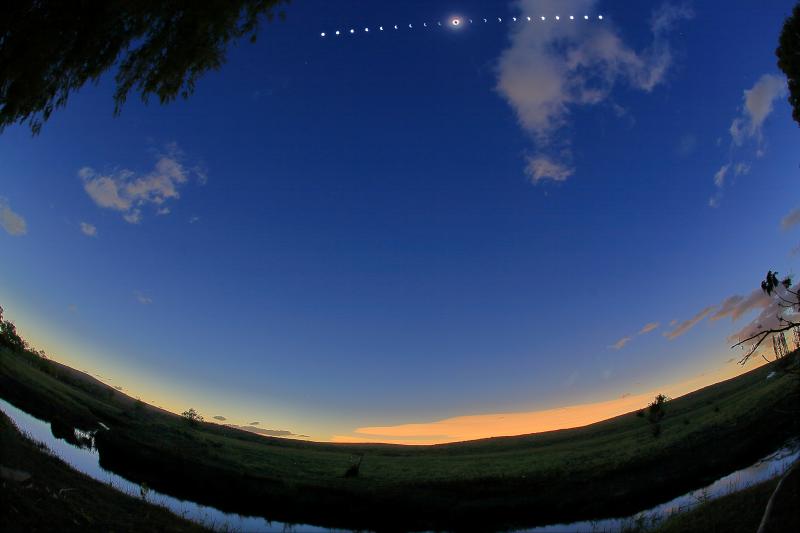
The total solar eclipse of 2020 Dec 14 began in the southern Pacific Ocean and first landfall was on the Chilean coast, near Champulli. The track of totality then swept across the Andes into the northern Patagonian provinces of Argentina, leaving land for the final time east of the Argentinian resort of San Antonio Oeste, and concluding in the southern Atlantic Ocean off the coast of Namibia.
Last year we both witnessed a stunning eclipse over the Andes, seen from Bella Vista in Argentina’s northern province of San Juan. The 2019 eclipse was popular, with thousands travelling to South America to see it, and similar numbers were expected for 2020. However, the global pandemic changed the situation completely. Both Argentina and Chile had high infection rates and imposed strict lockdowns, with a total ban on foreign visitors from March onwards. The restrictions on travel worldwide meant that most tour companies cancelled their eclipse plans.
Nevertheless, a window of opportunity began to inch open. As the southern hemisphere summer approached, infection rates were falling in both countries, and the authorities began to contemplate admitting visitors. Chile reopened its borders to foreigners at the beginning of December. The authorities in Argentina were a little slower, but several tour companies, both in Argentina and outside, negotiated for tours to enter, specifically to view the eclipse. Eventually an agreement was reached to allow up to 180 foreign visitors to enter the country, and 94 of these permits were taken up.
We were the guest astronomers on the two tours organised by Astro Trails, attended by 40 of the 94 permit holders. Visiting conditions were very strictly regulated; tour members had to have had a negative coronavirus test within 72 hours of travelling to Buenos Aires, and the entire party were retested on our first night in the city. Throughout our stay, we couldn’t get on a tour bus without having a temperature check and hand-sanitising. Masks were compulsory. Buenos Aires was quiet; the Plaza de Mayo square at the city centre, by the Casa Rosada, usually throngs with tourists but was instead eerily silent, home to just a few demonstrators. The bohemian suburb of La Boca was busier, but even here, stallholders were surprised to hear English spoken by visitors.
After a day in Buenos Aires, the party split into two tours. One group (headed by MF) flew to Neuquén, the largest city in Patagonia, whilst the second (with NJ) were based in the beautiful tourist resort of Bariloche, in the foothills of the Andes. Ordinarily, we would hold an eclipse briefing the night before the eclipse, but for this tour we recorded one for viewing in advance (with the added help of Sheridan Williams, who was unable to tour).
Getting ready
On eclipse morning the two groups drove to our viewing site near Piedra del Águila, Neuquén province. All on board carried the travel permits we had been issued, but traffic was light and we were waved through the checkpoints. Our site had been chosen because the probability of cloud was the lowest of any on the centreline. It was also close to the point of maximum eclipse, and so the Sun was high in the sky (altitude 72°) at the time of totality.
Our exact location was at Fortin Nogueira, an estancia (ranch) on the banks of the Limay River (at 39° 57′ 42″ S, 69° 59′ 34″ W). Most of Neuquén province is arid, undulating scrubland, but a few rivers snake across the terrain and, where there is water, there is lush vegetation and the opportunity for agriculture and habitation. Fortin Nogueira was an idyllic location; a horse ranch with paddocks bounded by high trees. A large Argentinian eclipse group (who we didn’t meet) were camped toward the river, and we were located on higher ground just beyond the paddocks. Totality would last 2min 6s at our location.

We soon understood why the paddocks were protected by trees. In the summer, Patagonia often has strong winds blowing in from the Andes, and eclipse day was no exception, with unrelenting blustery winds of 40–50mph. An observing area had been prepared with hay bales to sit on, but it was clear straight away that the chosen site was unsuitable. One of the portaloos had already been blown into a stream (fortunately there was no one in it at the time!). We were assured that the paddocks were available for our use, and a quick reconnoitre established that a nearby one, shielded by trees, was a much calmer location, suitable for setting up tripods and cameras. Unfortunately, the path to the paddock involved crossing the stream on a tree log, but the gauchos from the estancia quickly brought along planks to form a second bridge and carried the bales across for us.
NJ’s plan was to get images of the eclipse using four cameras, which would operate without much input during totality. The first three were a GoPro Hero 6 for wide-angle video (this had a wide enough field to get the ground and Sun in at the same time), a Panasonic TM700 camcorder for medium-scale video and a Sony A7s camera with a 100mm ƒ/2 lens, taking medium-wide-field stills through totality. All of these were on fixed tripods and the A7s was pointed to get the starfield west of the Sun, where a known comet (C/2020 S3 Erasmus) would be visible around 11° west of the eclipse. The final setup was a ZWO ASI183 camera and a 500mm, ƒ/8 Tamron mirror lens on a Star Adventurer equatorial mount. This had a field of view of 1.5×1.0° with a resolution of 5.5×3.7k and was capable of taking 7.5 frames per second, generating around 70GB of image data through totality. It was intended to get high-resolution prominence and inner corona images.
126 breathtaking seconds
First contact was at 11.45 a.m. local time. As the Moon made its way across the Sun, we enjoyed lunch, and carried out many of the traditional experiments for partial phases. The farmworkers were amused by the colander which one of us (MF) used to project pinhole images of the Sun, and we showed them the way in which shadows distorted and sharpened as the light source became crescent-shaped. A warm sunny day, with the Sun high in the sky, became cooler, and this cooling seemed to trigger the formation of patches of light cloud which rushed across the sky. There was only one small sunspot (AR12792) and this was covered up around 15 minutes before second contact.
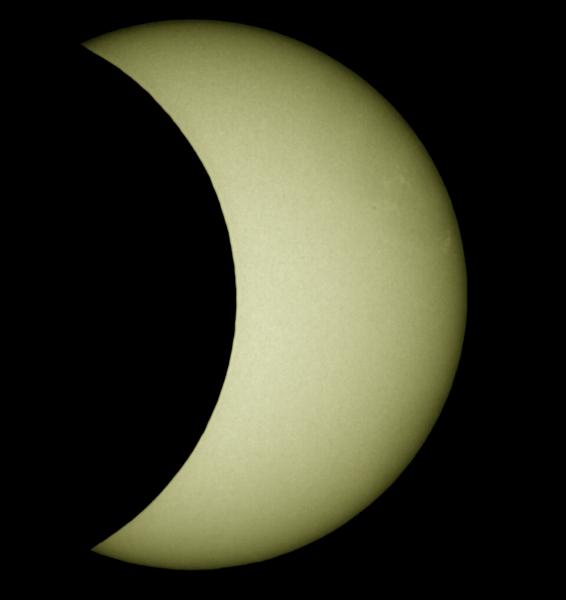
As the crescent split into ‘Baily’s beads’, Venus became visible 25° to the left of the Sun. Second contact was due at 1.08 p.m. local time. We watched out for the onrushing shadow of the Moon from the WNW, but the trees made it difficult to see. Instead, our attention was caught by the shadow bands on the ground. A white sheet showed hoped-for bands of narrow width travelling roughly west to east, as predicted, but there also seemed to be much larger bands of light, sweeping across the paddock. It was surmised that we were seeing ‘cloud bands’, where the change in luminosity was due to diminution by passing cloud. Readers will be familiar with shadows crossing the landscape on a day of sun and patchy cloud; perhaps when almost all the Sun is covered the illumination levels are more sensitive to the amount of cloud between it and the observer. As in a previous eclipse (Hao Island, 2010), imagers recorded shadow bands projected onto the intervening thin cloud.
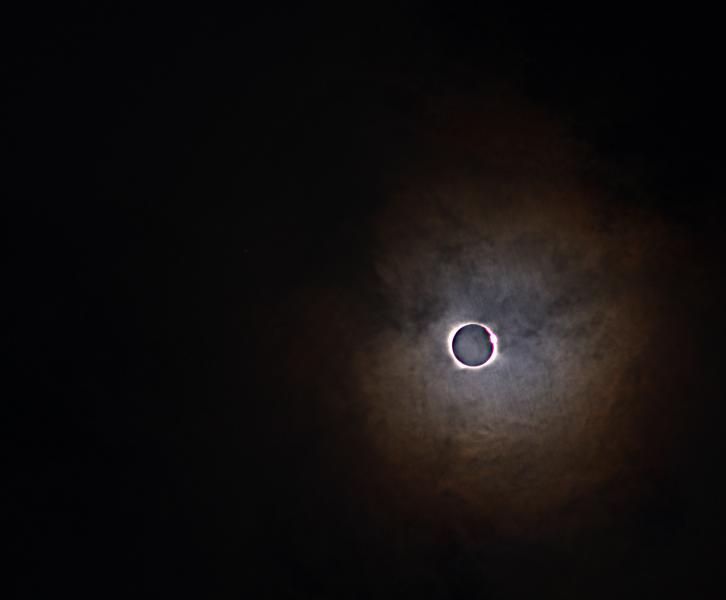
Totality came on us just as the Sun was still covered with cloud; this produced the most beautiful meteorological corona – a double ‘rainbow’ of light close to and around the Sun, caused by diffraction of sunlight by the water drops in the cloud. In a year of coronavirus, a corona created by corona light seemed very appropriate. An image by Andreas Möller, who was on our tour, captured the solar corona, cloud corona and projected shadow bands; these features were also captured on NJ’s wide-field stills and video.
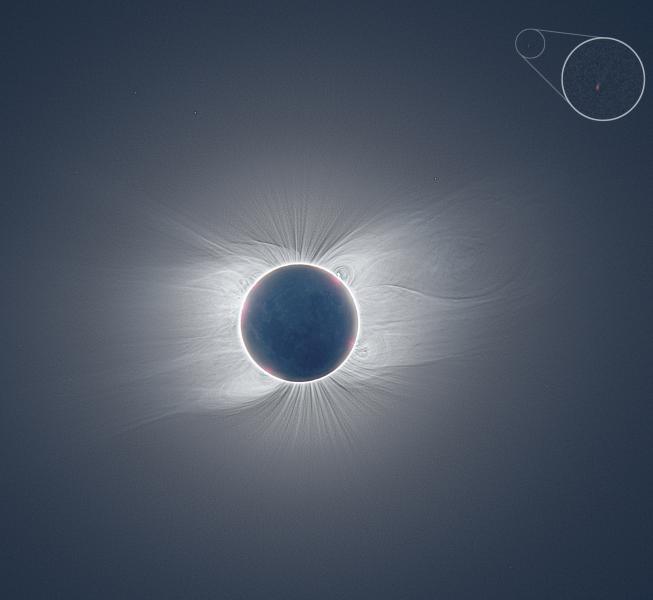

Mercury popped into sight 3° to the left of the Sun, and the close conjunction of Jupiter and Saturn was visible 35° away to the right. From our viewing point, trees blocked much of our horizon, but Philippe Lopez, who chose to observe a short distance away, photographed an all-sky shot with a red glow on the horizon to the north (see image at top of article).
The thin cloud covered the Sun for just under the first 30 seconds of totality, but it didn’t stop us viewing the solar corona and prominences. The former was close to predictions; a typical solar minimum corona with well-defined polar brushes and one very long coronal streamer. Processing of coronal images showed several loops and a coronal mass ejection to the right of the Sun. In binoculars there were multiple prominences; at least four were easy to see as soon as totality was underway. The Moon was moving from left to right and so, as the large prominences on the right-hand (eastern) limb of the Sun were covered up, the ones on the left became more prominent. No major detached prominences were seen.
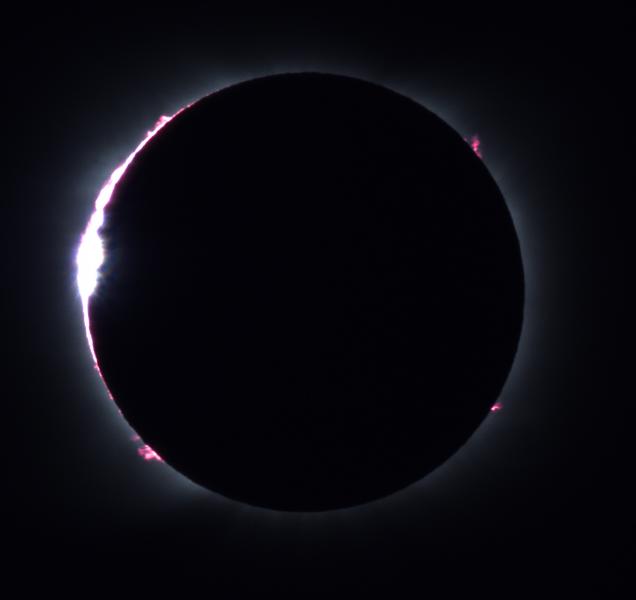
In the latter part of totality, there were further fast-passing patches of very thin cloud. The diamond ring arrived after 126 breathtaking seconds of totality. The Moon’s shadow headed off towards the east and there were further shadow bands, similar to those seen at second contact, but this time with the Sun in a clear sky.
We celebrated a glorious total eclipse with champagne. The horses realized our field was full of hay bales, and once they had decided we weren’t going to trouble them, began to eat our seating. The temperature began to rise again. The family who owned the estancia came to join us. Once fourth contact had passed, we made our way back to the buses, paused for a (socially distanced) team photo, and headed back to our hotels.

Looking at NJ’s wide-field images after the eclipse, it was clear he had managed to record two comets close to the Sun during totality. C/2020 S3 (Erasmus) was there in its expected position, along with sungrazer comet C/2020 X3 (SOHO) which had been discovered the day before by Worachate Boonplod. We believe that this may be the first time that two comets were imaged at the same totality. Andreas Möller also picked up the sungrazer in his excellent corona images and he was mentioned in a NASA press release.1 In NJ’s images C/2020 S3 displays the conventional green CN emission expected of a healthy comet, but C/2020 X3 is yellow, presumably due to Na emission as the comet was vaporised by the Sun.
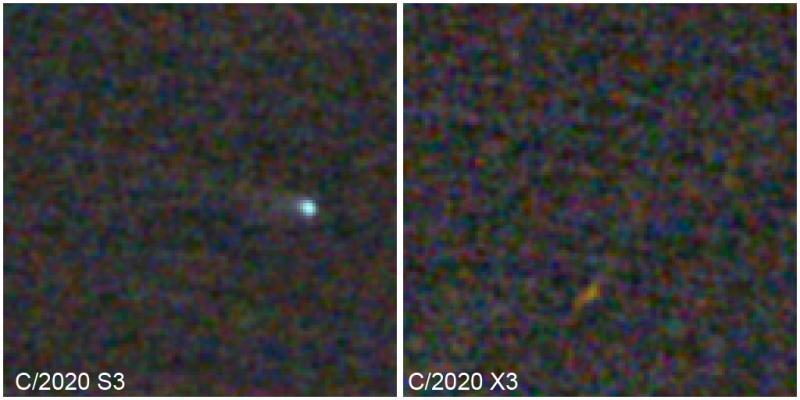
The choice of the Piedra del Águila area for the observing site was wise. On the Chilean side of the Andes, there was heavy rain, and only a few people managed a glimpse of totality. Rain also disrupted viewing on the Atlantic coast of Argentina. But the weather, bar a few clouds, was clear across central Patagonia. It is such a pity that so few people were able to enjoy it.
The weather continued to favour us in the succeeding days of the tour. In addition to a sightseeing tour on Bariloche Lake, the Bariloche group were able to enjoy an evening of southern stargazing from a dark site around 20km east of Bariloche town. The Neuquén-based astronomers didn’t have an opportunity for dark-sky observing, but were able to view several southern clusters, as well as a barn owl hunting, from a site close to the hotel.
This was an eclipse that few of us expected to be able to attend – getting a tour group into Argentina and then to the observing site demanded a mastery of bureaucracy and painstaking negotiation skills. Much kudos is due to Julie and Brian at Astro Trails, and to the staff of the local agents, Eurotur.
Nick James, Director, Comet Section, and Mike Frost, Director, Historical Section
1 NASA press release: go.nasa.gov/35u948K
| The British Astronomical Association supports amateur astronomers around the UK and the rest of the world. Find out more about the BAA or join us. |
